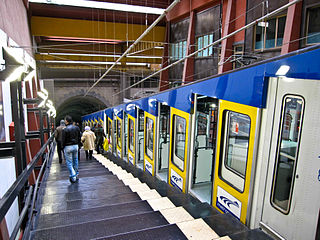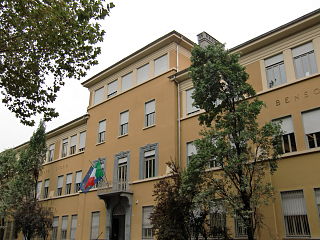
Jacopo Sannazaro was an Italian poet, humanist, member and head of the Accademia Pontaniana from Naples.

EUR is a residential and business district in Rome, Italy, part of the Municipio IX.

Vomero is a bustling hilltop district of metropolitan Naples, Italy — comprising approximately two square kilometres (0.77 sq mi) and a population of 48,000.

Liceo scientifico is a type of secondary school in Italy. It is designed to give students the skills to progress to any university or higher educational institution. Students can attend the liceo scientifico after successfully completing middle school.

The liceo classico or ginnasio is the oldest public secondary school type in Italy. Its educational curriculum spans over five years, when students are generally about 14 to 19 years of age.

Beniamino Cesi was a celebrated Italian concert pianist and teaching professor of piano, who taught many of the most distinguished early 20th century pianists of the Neapolitan school, so that his influence spread very widely.

The Four Days of Naples was an uprising in Naples, Italy, against Nazi German occupation forces from September 27 to September 30, 1943, immediately prior to the arrival of Allied forces in Naples on October 1 during World War II.

The Chiaia Funicular is one of four funiculars in the public transportion system of Naples, Italy. Each system is a true funicular: an inclined railway with two passenger cars connected via cables, operating in concert.

The Montesanto Funicular, is one of four operating funiculars in the public transportion system of Naples, Italy. The system is a true funicular: an inclined railway with two passenger cars connected via cables, operating in concert.

The Conservatorio Statale di Musica "Gioachino Rossini" is a music conservatory in Pesaro, Italy. Founded in 1869 with a legacy from the composer Gioachino Rossini, the conservatory officially opened in 1882 with 67 students and was then known as the Liceo musicale Rossini. By 2010 it had an enrollment of approximately 850 students studying for higher diplomas in singing, instrumental performance, composition, musicology, choral conducting, jazz or electronic music. The conservatory also trains music teachers for secondary schools and holds regular master classes. Its seat is the 18th century Palazzo Olivieri–Machirelli on the Piazza Oliveri in Pesaro. Amongst its past Directors are the composers Carlo Pedrotti, Pietro Mascagni, Riccardo Zandonai and Franco Alfano. Mascagni's opera Zanetto had its world premiere at the conservatory in 1896.

Liceo Ginnasio statale "Camillo Benso di Cavour" is the oldest Liceo classico in Turin and one among the oldest and most prominent high schools in Italy, for pupils aged 14 to 19. It was transferred to its present location in 1931.

The Lycée français Chateaubriand is a French international primary and secondary school with two campuses consisting of three buildings in Rome, Italy. Its administration and senior high school/sixth-form college classes are located in the historic Villa de Via Patrizi building, while other classes are held at a former Christian private school and at the Villa Strohl-Fern.
Liceo Classico “Quinto Orazio Flacco” is the oldest institution for secondary education in the city of Bari, Apulia, Italy. Commonly known as Flacco, this liceo classico welcomes students from 14 to 19 years of age. The scholastic environments are still located in the original building, which was built along a stretch of Bari’s Lungomare in 1933.

Liceo scientifico statale Camillo Cavour is a liceo scientifico located in Rome, in via delle Carine 1, in Rione Monti. It was the first scientific high school in Rome, and potentially in the whole Italy.

The Liceo ginnasio Emanuele Duni is an Italian high school located in Matera, in the region of Basilicata in Southern Italy. It is named after Italian philosopher Emanuele Duni, professor of canon and civil law at the University of Rome. It is best known for having been the school where the Italian poet Giovanni Pascoli worked as a teacher in the two-year period 1882–1884.

The Colli Aminei are an area of Naples, Italy, that is part of the municipality of Stella-San Carlo at the Arena, specifically of the Stella district. It is bordered to the west and north by the Vallone di San Rocco, to the east by the Capodimonte ascent, to the south by the valleys of the Scudillo and the Fontanelle.

The Petraio is a lineal urban neighborhood and pedestrian road in Naples, Italy. It descends from what was once an expansive upper agricultural area and connects adjacent neighborhoods to downtown Naples — terminating just outside the original perimeter walls of Naples, near the present day Chiaia district.

The Liceo statale "Niccolò Machiavelli" is a high school named after Niccolò Machiavelli located in the historic Oltrarno quarter of Florence, Italy. In the 2020 academic year it offered the secondary schools Liceo classico, Liceo delle Scienze Umane, Liceo Linguistico and Liceo Scientifico. It has a student population of over 1700, making it the second largest high school in the province. Initially based in the Fortezza da Basso, the school was moved Palazzo Rinuccini, in Via S. Spirito, in 2004. The branch of the school housing the international linguistic and international scientific departments is located in Palazzo Frescobaldi, also known as Della Missione. It is one of the oldest Italian normal schools for girls and has hosted the courses of one of the two Royal Higher Education Institutes.

The history of cinema in Naples begins at the end of the 19th century and over time it has recorded cinematographic works, production houses and notable filmmakers. Over the decades, the Neapolitan capital has also been used as a film set for many works, over 600 according to the Internet Movie Database, the first of which would be Panorama of Naples Harbor from 1901.